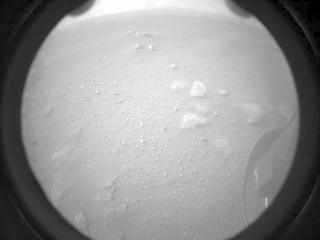They've done it again. After a journey of nearly seven months for the Perseverance rover, the Navigation and Entry, Descent and Landing teams successfully guided their intrepid traveler to a pinpoint landing inside Jezero Crater on Mars on February 18, 2021.
And within minutes of the landing, Perseverance sent back two images from the front and rear Hazard Avoidance Cameras, revealing its surroundings on the Red Planet.
I love the first image, above, from the Front Left Hazard Avoidance Camera A, because it shows Perseverance's shadow on Mars. To me, this image says, "I'm here, we made it!"
Below is the view from the second picture the rover beamed back, from the Rear Right Hazard Avoidance Camera, showing all the things planetary rover scientists like to see: rocks to study, and an immediate flat place to drive around.
For the first time, the rover teams were able to quickly determine exactly where Perseverance had landed. That's because part of Perseverance's new landing system was a new navigation package that took images of the landing area and compared them with maps to pick out a safe spot to touch down. "This is finally like landing with your eyes open," said NASA scientist Swati Mohan who provided the play-by-play during the NASA livestream of the landing.
Loading tweet...
— View on Twitter
Loading tweet...
— View on Twitter
There's a rumor more images will be released today, perhaps even some from the Entry Descent and Landing (EDL). Another rumor says by Monday, NASA may be able to release the video and audio the rover's landing system took. Audio from one of the rover's microphones (read more about them here) will be paired with full-color video taken by the EDL cameras. This will allow viewers to experience what landing on Mars both looks and sounds like for the very first time. So, stay tuned!
#ICYMI @NASAPersevere landed on Mars yesterday! Check out all the details of landing here:
Loading tweet...
— View on Twitter
Originally tweeted by NASA Langley Research Center (@NASA_Langley) on February 19, 2021.
 Universe Today
Universe Today

